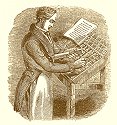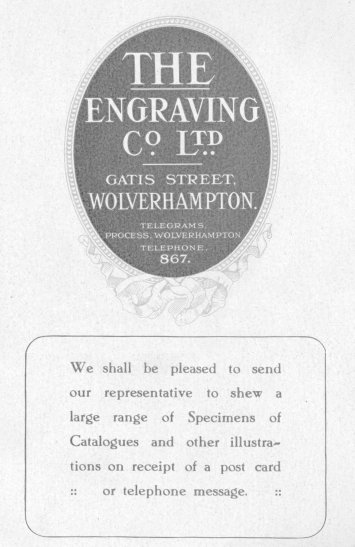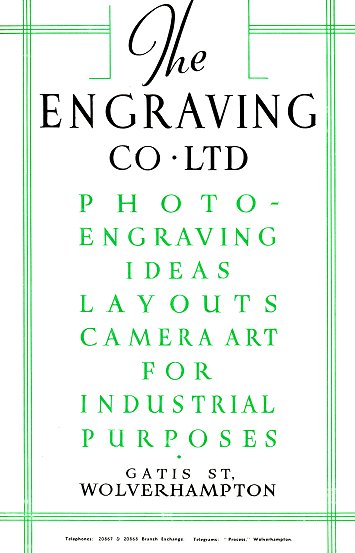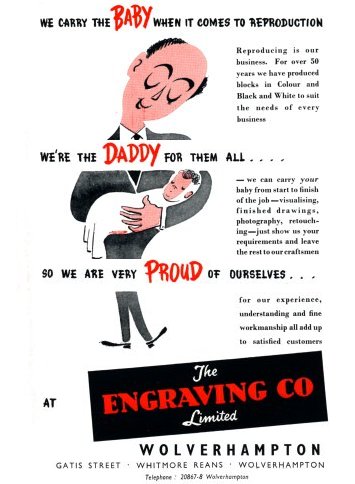 |
Wolverhampton Printers
The Engraving Company
|

|
| This company did not carry out printing but they did
make blocks - the things from which pictures are printed.
This was something of a specialised art and many printers
would not have undertaken it themselves - they sent the work
out to specialist such as this company. We can only trace their history through their own
entries in the Wolverhampton handbooks.
From these entries we find that "towards the end of the
nineteenth century Charles W. Harness began in business as a
wood engraver, also undertaking copperplate engraving,
photography and the making of blocks for the local newspaper The
Express and Star."
Charles Harness was born around 1874 in Hull, and by 1881
had moved to 6 Drummond Street, Wolverhampton, where he
lived with his parents, George and Sarah, and 4
sisters, and a brother.Their various entries in the 1960s refer to their main
business interests as being colour engraving, half-tone and line
blocks, commercial photography lay-outs, fine art reproductions
and commercial artwork. The company was incorporated in
1919 but was still run by the Harness family, and they seem
to have continued in control for as long as we can trace. |
 |
|
 |
|
An
advert from 1915. |
|
An
advert from 1914. |
|
| This invoice was sent in 1918 to Bennett Clark,
the Wolverhampton photographer. The last line says "Under
the management of Charles W. Harness" |
 |
 |
This statement was also sent to Bennett Clark in
1918. The two styles of heading could hardly be more
different.
Both documents are courtesy of the late Jim Boulton. |
 |
|
 |
|
Two
adverts from 1925. |
|
 |
|
 |
|
Two adverts from 1930.
|
|
 |
|
 |
|
Two
adverts from 1938. |
|
 |
This picture (taken from a
company catalogue, by courtesy of David Wilsdon) shows the company's
large studio for photographing large items - in colour too. |
 |
|
 |
|
An
advert from 1951. |
|
An
advert from 1958. |
|
|

An advert from 1956. |
| In the 1967 handbook they say: "The company
has steadily developed until it now finds itself the subsidiary of a
group of companies with wide interests in the graphic arts field,
and has further developed Being the only company of its type
in the town, it has a wide range of services to offer to local
advertisers and printers. A new purpose-built factory is in the
course of construction within the town centre, and on completion
will greatly improve the services offered."
The demise of the company has been relayed to us by Michael
Hubbard whose brother worked there until 1966/7. He says
that the company never moved to new premises but was taken over
by Lucas Engravers of Livery Street, Birmingham, who
transferred all the business and staff to the Birmingham
address. The Gatis Street site was abandoned.
|
|

The staff of the Wolverhampton
Engraving Company in the 1920s.
Third from the right, in the middle
row, is George Ireland Mackie. The gentleman in the centre
of the front row is believed to be Charles Harness. The
photograph was kindly sent by George Ireland Mackie's
grandson, Alan Mackie.
George Ireland Mackie was born in
Glasgow in1877, and served his apprenticeship as a copper
plate engraver in Edinburgh. At the end of his
apprenticeship he moved to Wolverhampton, and found
employment at the engraving company. In the 1930s he left
and set up as a jewellery engraver, with premises on the
corner of Princess Street and Queen Street, Wolverhampton.
He carried out a lot of work for T. A. Henn, the jewellers
in Princess Street.
George had 2 sons who also followed him into the printing
trade. The eldest, James, was a commercial artist at the
engraving company, and the youngest, John (Alan's father),
was a letterpress half tone etcher, working in Birmingham.
Alan also worked in the trade as a letterpress hand
engraver, and later transferred to litho production.
Third from the right on the front row
of the photo above, is Albert Theodore Williams. Albert had
completed an apprenticeship as an engraver and was a half
tone engraver for copper and zinc. He was conscripted from
1915-1919 and served in the North Staffs and then the14th
Battalion Northumberland Fusiliers. After demobilisation, he
worked at the Wolverhampton Engraving Company. The
photograph was probably taken before his marriage in 1924.
He worked in Birmingham for around 6 years from 1927 and
then returned to the Wolverhampton Engraving Company. |

A photo of the staff in the 1960s.
3rd from the left in the middle row is Albert Theodore
Williams.. The photo was kindly sent by his
granddaughter, Erica Williams. |

A sample of George Ireland Mackie's work. Courtesy
of Alan Mackie.

|

|
|
Return to the
Printing Hall |
|